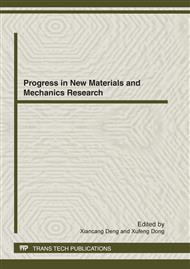[1]
R.J. Day, K.D. Hewson, P.A. Lovell, Surface modification and its effect on the interfacial properties of model aramid-fibre/epoxy composites, Compos. Sci. Technol. 62(2002) 153-156.
DOI: 10.1016/s0266-3538(01)00135-x
Google Scholar
[2]
C.Y. Yue, G.X. Sui, H.C. Looi, Effects of heat treatment on the mechanical properties of Kevlar-29 fibre, Compos. Sci. Technol. 60(2000) 421-427.
DOI: 10.1016/s0266-3538(99)00137-2
Google Scholar
[3]
R.J. Young, D.J. Bannister, A.J. Cervenka, I. Ahmad, Effect of surface treatment upon the pull-out behaviour of aramid fibres from epoxy resins, J. Mater. Sci. 35(2000) 1939-1947.
Google Scholar
[4]
M.G. Dobb, D.J. Johhson, B.P. Saville, Supramolecular structure of a high- modulus polyaromatic fiber (Kevlar 49), J. Polym. Sci. 15(1997) 2201-2211.
DOI: 10.1002/pol.1977.180151212
Google Scholar
[5]
W.F., McDonald, M.W. Urban, Modification of the PPTA fiber surfaces by ultrasonic waves, Polym. Mater. Sci. Eng. 59(1988) 306-310.
Google Scholar
[6]
R. Benrashid, C. Tesoro Giuliana, Effect of surface-limited reactions on the properties of Kevlar fibers, Text. Res.J. 60 (1990) 334-344.
DOI: 10.1177/004051759006000604
Google Scholar
[7]
E.M. Kim, J. Jang, Surface modification of meta-aramid films by UV/ozone irradiation, J. Fiber Polym. 11 (2010) 677-682.
DOI: 10.1007/s12221-010-0677-5
Google Scholar
[8]
L.M. Plawky, W. Michaeli, Surface modification of an aramid fibre treated in a low-temperature microwave plasma, Mater. Sci. 31(1996) 6043-6053.
DOI: 10.1007/bf01152157
Google Scholar
[9]
K. Kuepper, P. Schwartz, Modification of the fiber-matrix interface of p-aramid fibers using gas plasmas, Adhes. Sci. Technol. 5(1991) 165-176.
Google Scholar
[10]
D. Knittel, W. Kesting, E. Schollmeyer, Surface structuring of synthetic fibres by UV laser irradiation. I. Phenomenological report, E. Polym. Int. 43(1997) 231-239.
DOI: 10.1002/(sici)1097-0126(199707)43:3<231::aid-pi797>3.0.co;2-e
Google Scholar
[11]
M. Mori, Y. Uyama, Y. Ikada, Surface modification of aramid fibre by graft polymerization, Polymer. 35(1994) 5336-5341.
DOI: 10.1016/0032-3861(94)90487-1
Google Scholar
[12]
F. Poncin-Epaillard, B. Chevet, J.C. Brosse, Study of an aramid surface reactivity: modification with a cold plasma or an electron beam followed by a postgrafting reaction, J. Appl. Polym. Sci. 52(1994) 1047-1061.
DOI: 10.1002/app.1994.070520806
Google Scholar
[13]
J. Maity, C. Jacob, C.K. Das, S. Alam, R.P. Singh, Direct fluorination of Twaron fiber and the mechanical, thermal and crystallization behaviour of short Twaron fiber reinforced polypropylene composites, Compos. Part A-Appl. S. 39(2008) 825-833.
DOI: 10.1016/j.compositesa.2008.01.009
Google Scholar
[14]
T. Ai, R.M. Wang, W.Y. Zhou, Effect of grafting alkoxysilane on the surface properties of kevlar fiber, Polym. Compos. 28(2007) 412-416.
DOI: 10.1002/pc.20313
Google Scholar
[15]
G.N. Fan, J.C. Zhao, Y.Q. Zhang, Z. Guo, Grafting modification of Kevlar fiber using horseradish peroxidase, Polym. Bull. 56(2006) 507-515.
DOI: 10.1007/s00289-005-0495-x
Google Scholar
[16]
T.M. Liu, Y.S. Zheng, J. Hu, Surface modification of aramid fibers with novel chemical approach, J. Polym. Bull. 66(2011) 259-275.
DOI: 10.1007/s00289-010-0313-y
Google Scholar
[17]
R. Park, J. Jang, Effects of hybridization on the mechanical performance of aramid/ polyethylene intraply fabric composites, Compos. Sci. Technol. 58(2004) 1621-1628.
DOI: 10.1016/s0266-3538(97)00228-5
Google Scholar
[18]
R. Mahmoud, D. Charles, Polymerization compounding of HDPE/Kevlar composites. I. Morphology and mechanical properties, Polym. Compos. 27(2006) 129-137.
DOI: 10.1002/pc.20159
Google Scholar
[19]
A.B. Coffey, C. M.O'Bradaigh, R.J. Young, Interfacial stress transfer in an aramid reinforced thermoplastic elastomer, J. Mater. Sci. 42(2007) 8053-8061.
DOI: 10.1007/s10853-007-1680-0
Google Scholar
[20]
J. Kalantar, L.T. Drzal, The bonding mechanism of aramid fibres to epoxy matrices, J. Mater. Sci. 25(1990) 4186-4193.
DOI: 10.1007/bf00581071
Google Scholar
[21]
A.A. Leal, J.M. Deitzel, S.H. McKnight, Jr. Gillespie, Interfacial behavior of high performance organic fibers, Polymer. 50(2009) 1228-1235.
DOI: 10.1016/j.polymer.2009.01.018
Google Scholar


